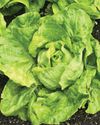
Some of the most common of these include prolonged heatwaves, increased drought conditions and, paradoxically, more flooding and extreme weather events, too.
In some cases, these conditions are contributing to lower crop yields or even total crop failure. According to a September 2009 study published in The Proceedings of the National Academy of Sciences, as temperatures continue to rise, U.S. corn and soybean yields could drop by at least 30% by the end of the century. What’s more, the overall nutritional value of crops such as wheat and soybeans also may be negatively affected. And that’s not all.
“We know that, with the increasing temperatures and the trajectory of climate change, we’re seeing increased incidence of pests and diseases, because the insects can survive in a broader landscape because the temperature is more amenable,” says Angela Records, chief scientific officer at the Foundation for Food & Agriculture Research (FFAR).
Fortunately, science-based solutions are in the works — as well as some more immediate agricultural practices that we can all put to work.
Heat-Resistant Varieties
Denne historien er fra March - April 2024-utgaven av Hobby Farms.
Start din 7-dagers gratis prøveperiode på Magzter GOLD for å få tilgang til tusenvis av utvalgte premiumhistorier og 9000+ magasiner og aviser.
Allerede abonnent ? Logg på
Denne historien er fra March - April 2024-utgaven av Hobby Farms.
Start din 7-dagers gratis prøveperiode på Magzter GOLD for å få tilgang til tusenvis av utvalgte premiumhistorier og 9000+ magasiner og aviser.
Allerede abonnent? Logg på

The RISE of Opportunist WEEDS
Be prepared to see increasing changes in weeds we fight, such as poison hemlock and poison ivy, and in the crops we grow.

LIVESTOCK Health
Prepare yourself for how to spot symptoms of illness in your farm animals so that you can get them help before it's too late.

CUT FLOWER Farming
If you're considering growing flowers for sale, brush up on these five key things to know before diving in.

WINTER Survival
Keep your land, animals and yourself in good shape this winter with this helpful advice.

COVERAGE CONCERNS
Avoid common insurance mistakes for rural and hobby farm businesses.

FARMER'S GUIDE Berries
Set the stage for tasty strawberries, blueberries and brambles with these soil-boosting garden tips.

Preconditioning CALVES
Follow our step-by-step guide to get more money for your calves.

Soil Conservation
Often, outside of having a specific problem that needs to be addressed, soil conservation isn't something every farmer readily thinks about. Yet conserving the soil should be at or near the top of every farmer owner or manager's list of concerns because absent the prevention of soil erosion, we have the opportunity for another dust bowl.

Year-Round Lettuce & Salad Mixes
It's easy to think of salad greens as just a spring- or fall-garden crop, but it's possible to enjoy freshly harvested lettuces, mustards and more from your own garden year-round.

Barn Improvements
Days are never long enough for a farmer. From dawn to well into the night, tasks arise that often require immediate action. Having to search for tools or equipment is an enormous time waster and incredibly frustrating when you can't find what you need, especially when you know you have it.